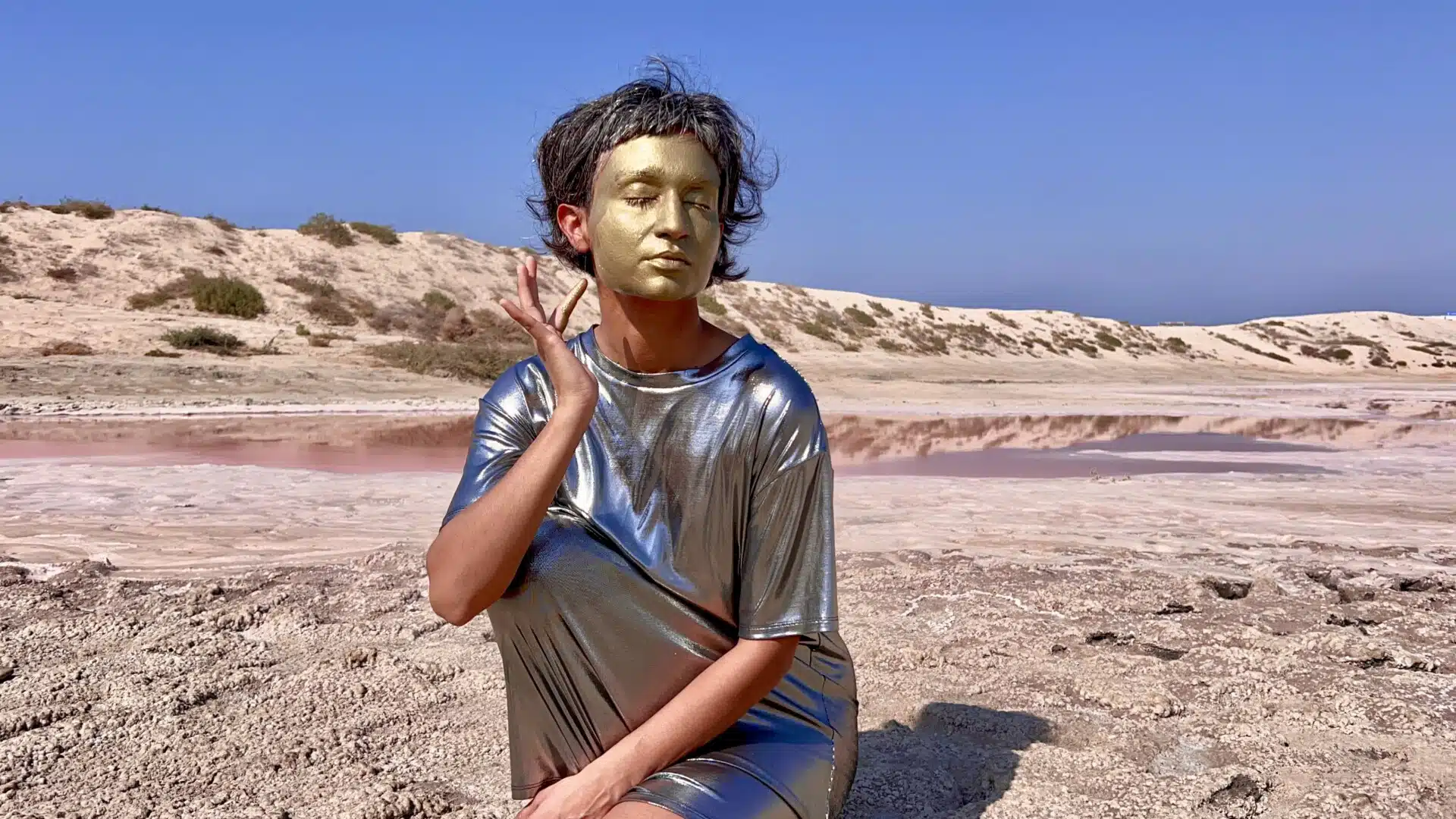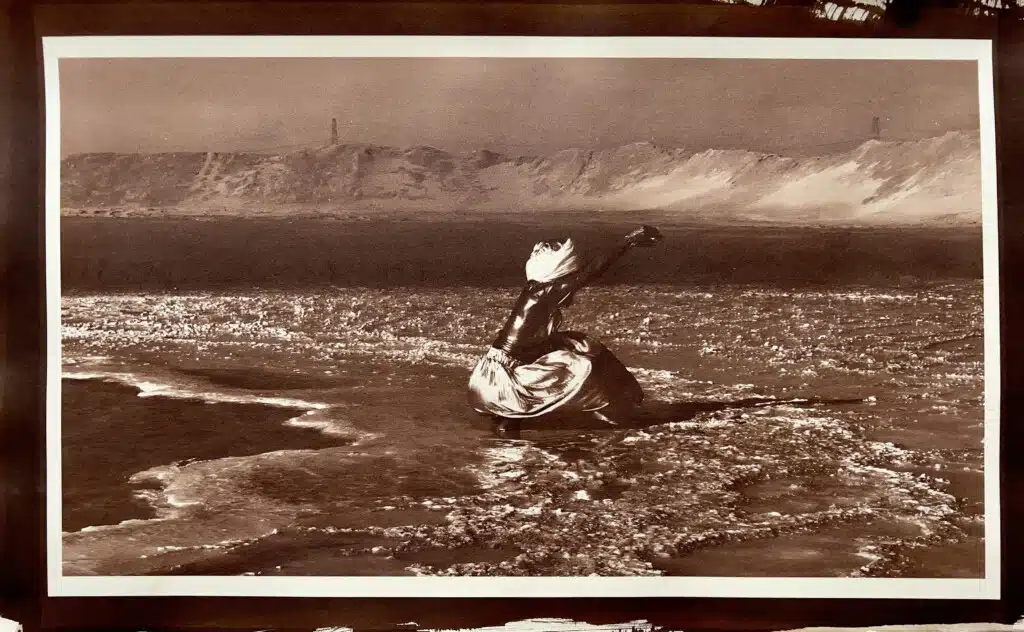TEXT: MAANAV JALAN, IN CONVERSATION WITH HYLOZOIC/DESIRES
Hylozoic/Desires (H/D), Himali Singh Soin and David Soin Tappeser’s artist duo, explore the various facets of salt — its political history, spiritual resonances and chemical properties as an artistic medium — in a series of multi-disciplinary installations in Sharjah, New Delhi and London taking place through 2025. The works take as their basis the ‘Great Hedge of India’, a long barrier made of thorny plants bisecting the South Asian subcontinent in the 19th century, maintained by the British Inland Customs Office to prevent the free movement of salt and to enforce a deadly salt tax. The Hedge, now absent from the landscape and without much archival presence, becomes a potent poetic and political device to explore the fragility of the seemingly solid, and the many ways in which indigenous people, creatures and matter refused and continue to refuse colonial impositions on their land, sustenance and desires.
The resulting series of works — a film, The Hedge of Halomancy, an embroidered Mashru tapestry, Mokshapat, a fabric installation, namak halal/namak haram, a video made on Google Earth, The Phantom Line, a soundscape, namak nazar [white noise], and a set of salt prints — are part historical archive, part speculative fiction, part lament, part romance; an effort to find new forms with which to tell unrecorded and unimagined stories of freedom. Below are a few interconnected words, concepts, places and people that thread through the works, which can be used as approximate guideposts in navigating the duo’s ambitious and gauzy story.
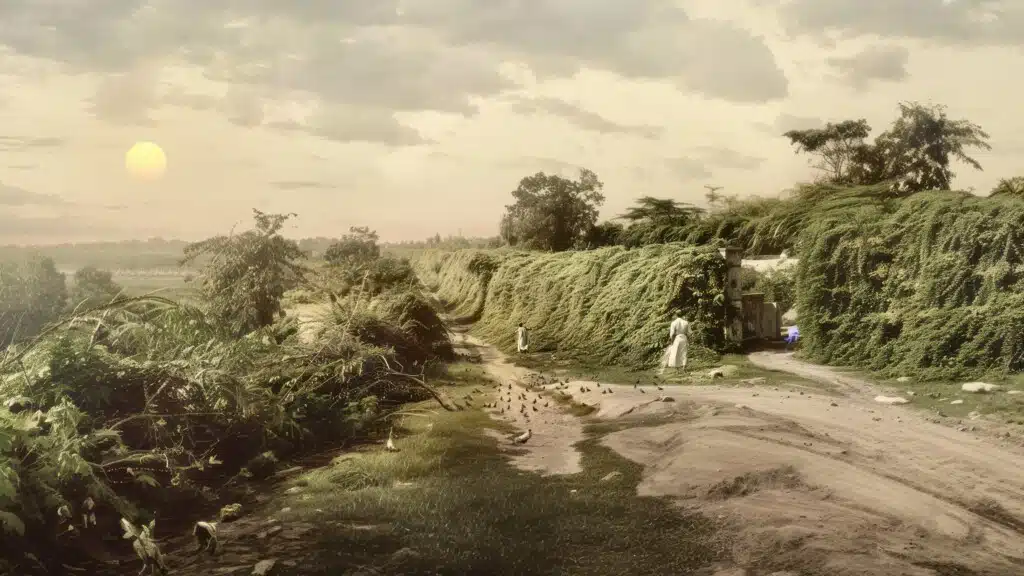
An AI Generated image of the ‘Great Hedge of India’ produced by Hylozoic/Desires, also used the film, The Hedge of Halomancy, 2025. Courtesy the artists.
INLAND CUSTOMS LINE
The Inland Customs Line was a 4000 km long customs barrier, with a 2500 km long section commonly referred to as ‘the Great Hedge of India’. The hedge was maintained by the East India Company and later the British Raj through a major portion of the 19th century to prevent the movement of salt smugglers across the subcontinent. Through an increasingly complicated series of taxation laws enacted through the 19th century, the British East India Company claimed total monopoly of the sale of salt in India, rendering all production and consumption of the essential ingredient illegal without being mediated by the Company and its exorbitant salt taxes. Like for other goods like sugar, tobacco and betel nut, a large contingent of customs officers and guards were employed to ensure that the unwieldy set of tax laws were upheld, many of whom patrolled the Inland Customs Line, running from the North-West edge of the subcontinent to the Bay of Bengal, cleaving the country in two halves.
“To my astonishment no one had heard of the Hedge,” wrote one of H/D’s sources in their research, Roy Moxham, upon arriving in India. The British historian gave shape to the Hedge in a 2001 book, triangulating it with the ‘Rambles and Recollections’ of colonial officers, reports and maps. In his travels around India and Pakistan, however, he failed to find evidence of the Hedge in people’s memories or the landscape. For H/D, the line is a speculation from the outset, concrete in its symbolisation of colonial rule yet porous with memory and archival holes, and full of conceptual possibilities. The video Phantom Line marks out a possible route of the hedge on Google Earth, using as its basis old administrative maps, one surviving guardpost and a route called Permit Line Road, running along a path in Northern India of what would’ve been a stretch of the Great Hedge. In the absence of photographs of the hedge, the artists have generated AI images of this vegetal wall, imagining it as an unruly garden, and materialised them using Victorian era salt-printing techniques. Among the archives cited by the artists in the project are traditional repositories such as the National Archives of India and AI image generators such as Midjourney.
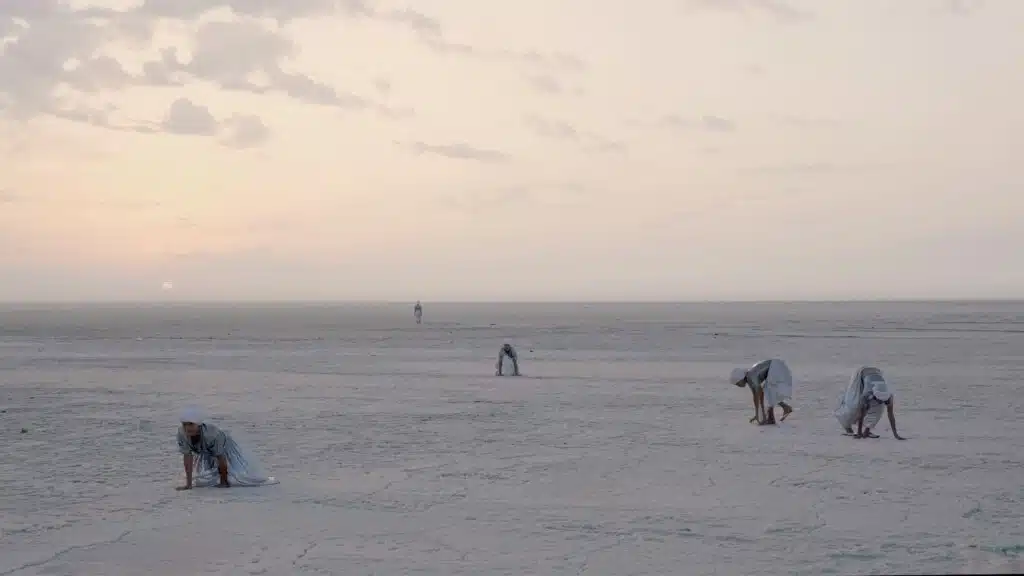
The Sambhar Salt Lake as a vast otherworldly expanse. Still from Hylozoic/Desires, The Hedge of Halomancy, 2025. Courtesy of the artists.
SAMBHAR SALT LAKE
The site of filming of The Hedge of Halomancy, the Sambhar Salt Lake in Rajasthan is more a vast otherworldly expanse than a watery lake, where a flat, blindingly white glimmer seems to extend beyond the horizon. The Lake fluctuates in its salt concentration through the seasons, becoming more dilute during the monsoon and highly saline in the preceding dry hot season. Pans of salt crystals form on the evaporated sections of the lake, and shallow pools reflect green, red, purple and pink depending on the types of salt-loving microorganisms living in the water. Greater and Lesser Flamingoes migrate to all of Western India between November and March, including to the Sambhar Salt Lake and the vast salt pans of the Rann of Kutch in Gujarat, where they feed on the salt, microorganisms, algae, crustaceans and other creatures that, turn their plumage pink. The birds return year after year to the site of their birth.
One of the largest sources of salt in Northern India, Sambhar’s salt economy was jointly controlled by the principalities of Jaipur and Jodhpur for centuries. Old havelis strewn across the landscape are reminders of this past, during which salt was not just a commodity but a symbolic token, bequeathed to subjects as a marker of their belonging to the land and kingdom. When the British took control of the Lake in 1879, this token was to become the right of onlythe Raj. Many colonial-style buildings from this time in Sambhar are now overgrown or derelict. In The Hedge of Halomancy, we see the remnants of the salt works and its infrastructure at the Lake, including the narrow gauge railways, along which the protagonist of the film, Mayalee walks.
MAYALEE
A protagonist of The Hedge of Halomancy, embodied and performed by Himali Singh Soin, with gold-flecked skin, sometimes wearing a silver sari and neon green mesh veil, and sometimes an elaborate victorian costume made from fabric sourced from waste material on the salt pans. In the historical record, Mayalee exists as marginalia in a colonial Foreign Department Proceedings document. In it, she is described as a “dancing girl” or courtesan in Sambhar who refused to accept a cash substitute from colonial officers in lieu of her traditional payment of 25 maunds of salt a year. With each maund being equivalent to approximately 37 kilograms, this payment is much more than may be needed in any one kitchen, marking its status not as a good, but a sign.
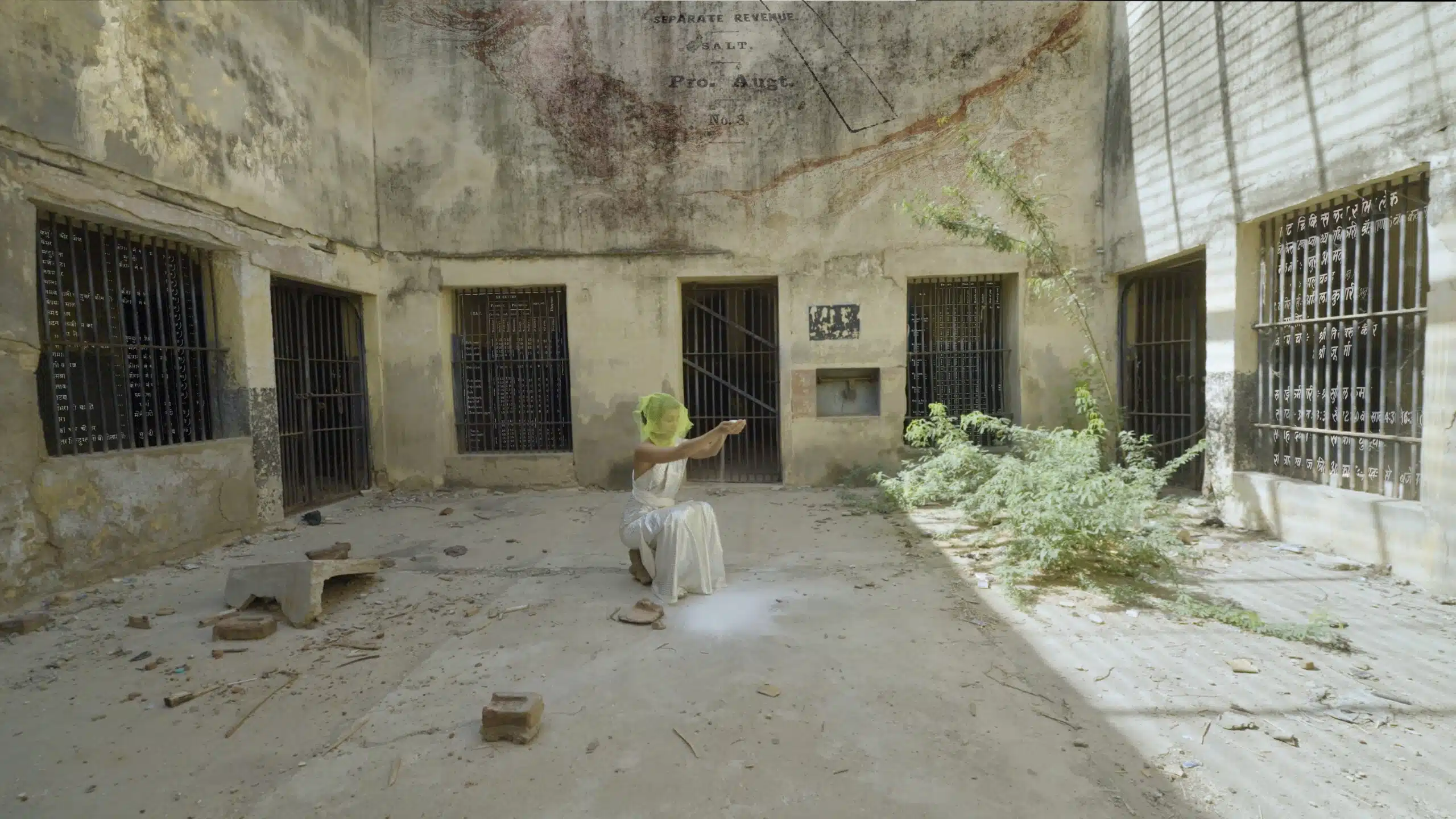
Top: Hylozoic/Desires, The Hedge of Halomancy, 2025, film still. Bottom: Salt print by Hylozoic/Desires, The Halomancer, 2024. Courtesy of the artists.
For music historian Katherine Butler Schofield, both Mayalee’s right to salt in the kingdom and successful refusal to abdicate it, indicates the importance of courtesans in the princely states, whose life and work are scarcely detailed in the colonial record. Mayalee’s name only finds its way in due to her confrontation with the salt revenue, and even then, only as marginalia. H/D takes the reference to her name as a point of departure for their speculative archive, placing her at its centre, in which she “plays the part and refuses the role”. Her means of refusal is imagined as an act of ‘halomancy’ by the duo, a way of prophesying — foretelling the collapse of the “hubristic project” of the great hedge — positing salt’s charge and edge as a magical property.
ALLAN OCTAVIAN HUME
It is only appropriate that a customs line composed of a myriad plant species would have been conceived of and supervised by A.O. Hume — a botanist and ornithologist nicknamed the ‘the Father of Indian Ornithology’ — during his tenure as Commissioner of Inland Customs. In his lifetime, Hume described at least 148 new bird taxa in the Indian subcontinent, including the Andaman Barn Owl, Nicobar Serpent Eagle and Manipur Bush Quail. As the Secretary of the Department of Revenue, Agriculture and Commerce, Hume also supervised India’s first national census in 1871, established a system for weather data collection and conducted topographical, geological and marine surveys.
Hume’s large collection of taxidermied bird specimens and significant ornithological writings were lost and stolen multiple times over his lifetime, once during the Indian Mutiny of 1857 and later again in 1883, during a visit to England. The next year, 20,000 specimens had to be discarded after being damaged in the monsoon rains, after which the still large collection was sent to the British Museum of Natural History. The lost manuscripts were never attempted to be rewritten by Hume. Bird skins of species that nested in the hedge, will be loaned from Hume’s collection at the Natural History Museum and shown as part of H/D’s exhibition at Somerset House, London.
After the British annexation of Sambhar lake and the consolidation of the salt taxation laws into a unified order across the country in the 1880s, Hume’s great salt hedge became obsolete, and was left to dissolve into the landscape. Meanwhile, Hume grew increasingly critical of the British colonial project and, after demotion from his post at the Secretariat, he became involved in occult and political circles, including in the Annie Besant Theosophical Society and the founding group of the Indian National Congress. H/D ask: what could cause such transformations and swings of fate? It is perhaps Mayalee’s whisperings that reach him, striking a chord in the conscience. We wonder if the staunch refusal in Sambhar could have sent ripples all the way to the heart of the empire, into today.
WHITE ANT
A small blind creature with four wings with a soft body and thin skin, White Ants were the notorious cause of damage and destruction of property and infrastructure across the British colonies in Africa, Australia, the West Indies and Asia, eating away at bamboo, cloth, glass, leather, tiles, roofing and wool. Rohan Deb Roy, in his detailed study of this important political actor in the 19th century colonies, describes these termites as particularly active in India, eating into the essential colonial materials of paper and wood. Revenue records, judicial documents, dictionaries — any and all bureaucratic material in paper was vulnerable to attack from the ants. The effects of the ants are passionately recorded in surviving colonial documents.
Alongside wooden infrastructure such as railroads, living architecture such as the Inland Customs Line too were prone to attacks by the ants. Hume himself lamented the creatures in 1867, causing almost half of the hedge to be destroyed annually. It is a creature that makes visible the hedge at a new scale and from a new perspective. The enormous system of administration is now not barrier but feed. After its abandonment as a project in1879, the Hedge, like reams of colonial paperwork, perhaps became the target of attack by White Ants. In this story, the White Ant is not just an agent of disobedience in its present, but through time, turning the archives to dust and the future into a space of holes.
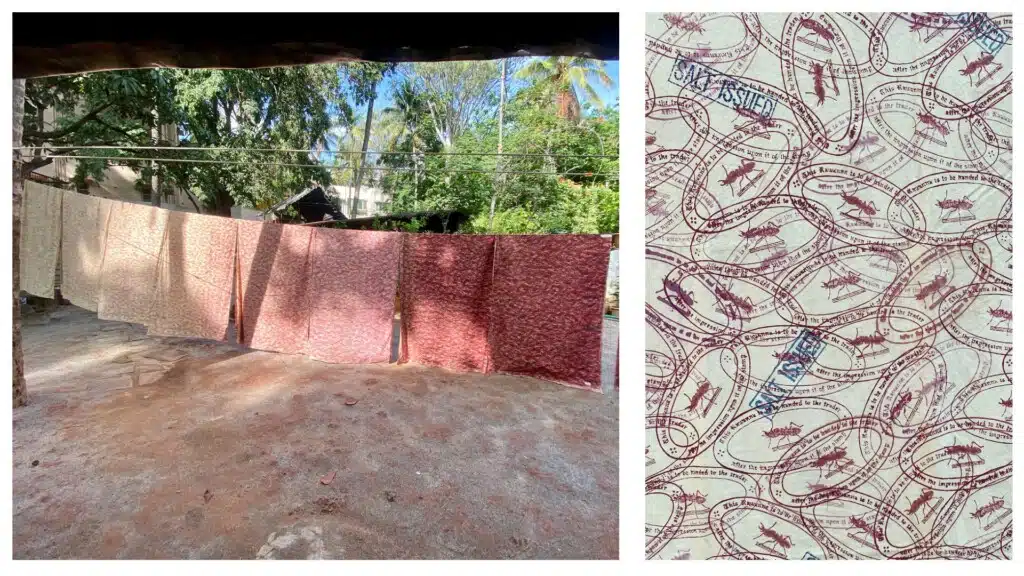
Works in progress for namak halal/namak haram , which will be installed at Somerset House, London in February 2025, with details of custom stamps featuring ants among other motifs. Hylozoic/Desires, Work in Progress for namak halal/namak haram, block print with natural dyes on organic cotton, 2025, 90 meters x 90 meters. Courtesy of the artists.
HALOMANCY
Halomancy is an act of divination that uses salt as its potent medium. It is a personal, political and poetic transformation, which we can imagine also as the process of art-making itself. For H/D’s soundscape Namak Nazar [white noise], the duo mix field recordings from the salt pans with the sounds of percussion instruments, such as shakers filled with salts of varying coarseness and weight. Their AI generated images of the Hedge are printed using salt-printing, an early 19th photographic technique in which a layer of salt solution on paper receives and stores the image. The prints are toned with pure gold, as is Mayalee’s skin, as if a heavenly body.
An embroidered tapestry made of Mashru fabric, with a cotton back and silk front, is imagined as a game of snakes and ladders, albeit in its indigenous Indian form, named Mokshapat. The game, traditionally “used as a divination tool with dice, charting the different paths towards enlightenment’, is invoked by H/D as a way to imagine the many possible paths to liberation. We can see each artistic conceit in the trail of installations created by Hylozoic/Desires, as such playful attempts to think with salt, cast a dice and a spell, to imagine the hedge and tunnel through it, all the while imagining a future with liberation as its light at the end.
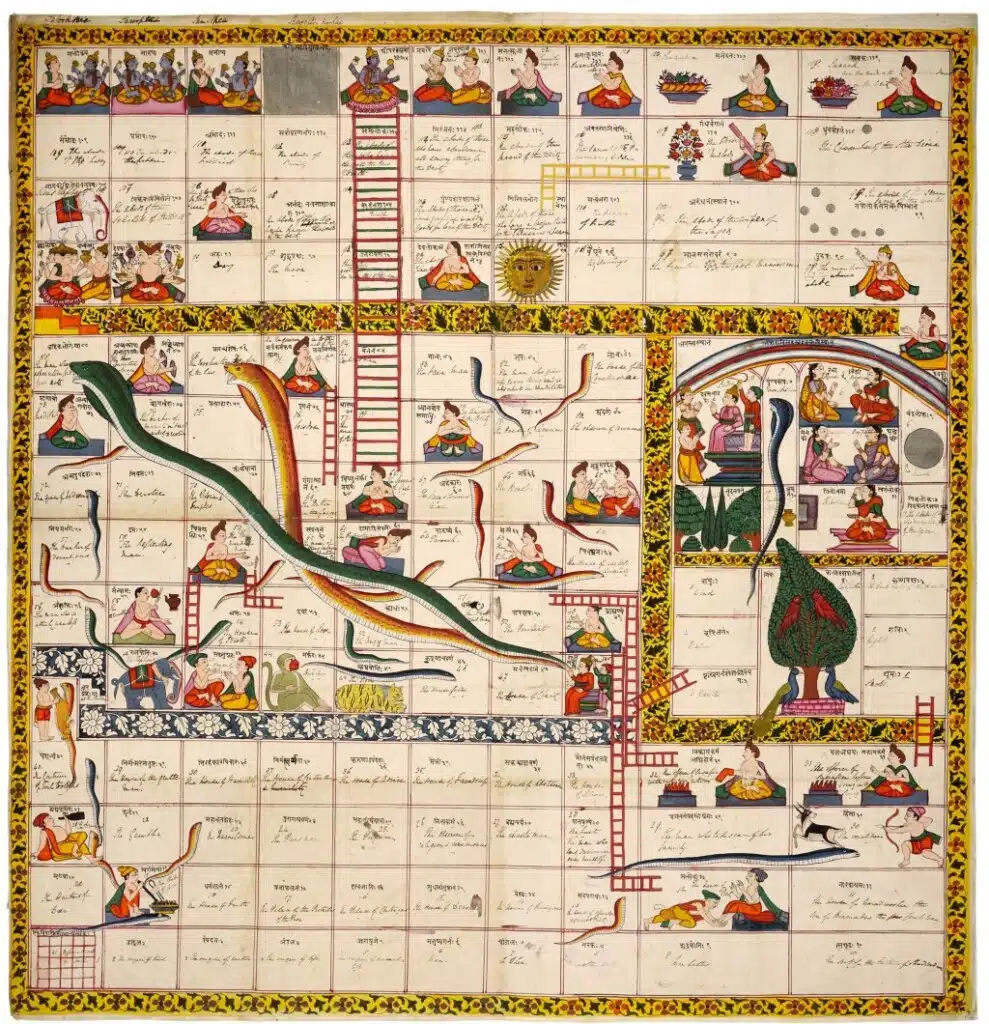
An image of a 13th century Indian Mokshapat board from Hylozoic/Desires’ research for their Mashru tapestry work. Courtesy of the artists.
The Hedge of Halomancy will be on view at India Art Fair 2025 in the Auditorium on 6 February, 2:00PM – 2:30PM and 8 February, 5:45pm – 6:15pm.
The film is co-commissioned by Sharjah Biennale 16 and Tate Britain, and supported by India Art Fair and Jaiveer Johal, through the Avtar Foundation for the Arts. Research support for the film came from Graham Foundation for the Arts and Alserkal Art Foundation.
Salt Cosmologies will be on view at Somerset House from 20 Feb till 27 April 2025, curated by Cliff Lauson and Kinnari Saraiya. The Hedge of Halomancy will be on view at Sharjah Biennial from 5 February till 15 June 2025, curated by Amal Khalaf; at Tate Britain from 27 February till 25 August 2025, curated by Dominique Hyse-Moore and Nathan Ladd. In March, the project will also be on view at the Chennai Photo Biennale.
Read more for yourself:
- Katherine Butler Schofield as Histories of the Ephemeral, A Bloody Difficult Woman: Mayalee Dancing Girl vs. the East India Company, Soundcloud, 2018
- N. J. Collar & R. P. Prys-Jones, Pioneer Of Asian Ornithology: Allan Octavian Hume in BirdingAsia, 2012
- Rohan Deb Roy, White ants, empire and entomo-politics in South Asia, Cambridge University Press, 2020
- Roy Moxham, The Great Hedge of India, Constable, 2001


